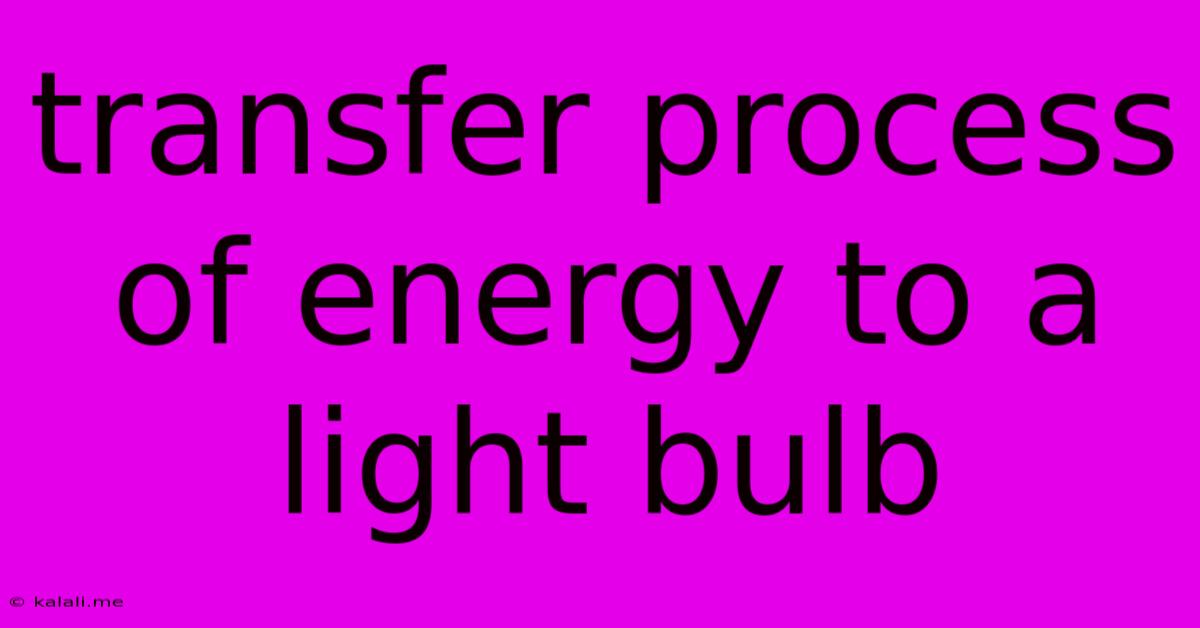Transfer Process Of Energy To A Light Bulb
Kalali
May 24, 2025 · 3 min read

Table of Contents
The Amazing Journey of Energy: How Electricity Powers a Light Bulb
Ever wonder what happens between flipping a light switch and the warm glow illuminating your room? It's a fascinating process involving the transfer of energy, transforming from one form to another. This article delves into the complete journey of energy, from the power plant to the light bulb's filament, explaining the physics and engineering behind this everyday marvel.
The Generation and Transmission of Electricity:
The story begins at the power plant, where energy is generated. Different sources – such as coal, natural gas, nuclear fission, hydroelectric dams, solar farms, and wind turbines – convert potential energy into electrical energy. This process typically involves spinning turbines connected to generators. The generator, based on Faraday's law of induction, converts mechanical energy into electrical energy. This electricity, usually in the form of alternating current (AC), is then stepped up to high voltage using transformers, minimizing energy loss during transmission across vast distances. High voltage transmission lines carry this electricity to substations near populated areas.
The Distribution Network and Step-Down Transformers:
At substations, the high voltage electricity is stepped down to a lower, safer voltage using transformers. This lower voltage electricity is then distributed through a network of power lines to homes and businesses. Further step-down transformers near homes reduce the voltage to the standard 120 volts (or 240 volts in some regions) suitable for household appliances.
From the Wall Socket to the Light Bulb Filament:
Once the electricity reaches your home, it flows through the wiring to your light switch and eventually to the light bulb socket. The light bulb, a simple yet ingenious invention, contains a thin filament, usually made of tungsten. When you switch on the light, the circuit is completed, allowing a flow of electrons – an electric current – through the filament.
The Transformation of Electrical Energy into Light and Heat:
This is the crucial step: the electrical energy is converted into light and heat within the filament. The filament's high resistance causes the electrons to collide with the atoms in the tungsten, generating heat. This heat causes the filament to become incredibly hot, reaching temperatures of around 2500° Celsius. At this high temperature, the filament begins to glow, emitting visible light. The spectrum of light emitted depends on the filament's temperature, with higher temperatures producing a whiter light.
Types of Light Bulbs and Energy Efficiency:
Traditional incandescent bulbs are highly inefficient, converting only about 5% of the electrical energy into visible light, with the rest wasted as heat. Modern alternatives, such as compact fluorescent lamps (CFLs) and light-emitting diodes (LEDs), significantly improve energy efficiency, converting a much larger percentage of electricity into light. LEDs, in particular, are known for their long lifespan and high luminous efficacy.
Understanding the Losses:
It's important to note that energy losses occur at various stages of this process. Resistance in transmission lines, transformers, and wiring all contribute to energy loss in the form of heat. While engineers strive to minimize these losses, some energy dissipation is unavoidable.
Conclusion:
The journey of energy from power plant to light bulb is a testament to human ingenuity and our ability to harness and transform energy sources. From the generation and transmission of electricity to the conversion of electrical energy into light and heat within the filament, the entire process involves a chain of energy transformations, highlighting the fundamental principles of physics and electrical engineering. Understanding this process helps us appreciate the importance of energy efficiency and the constant drive for innovation in lighting technology.
Latest Posts
Latest Posts
-
A Tie Is Like Kissing Your Sister
May 24, 2025
-
Run Cat 5 In Attic Or Crawl Space
May 24, 2025
-
Chicken Tikka Masala Vs Chicken Curry
May 24, 2025
-
Is An Isosceles Triangle An Equilateral Triangle
May 24, 2025
-
Real Numbers As A Vector Space Over The Rationals
May 24, 2025
Related Post
Thank you for visiting our website which covers about Transfer Process Of Energy To A Light Bulb . We hope the information provided has been useful to you. Feel free to contact us if you have any questions or need further assistance. See you next time and don't miss to bookmark.